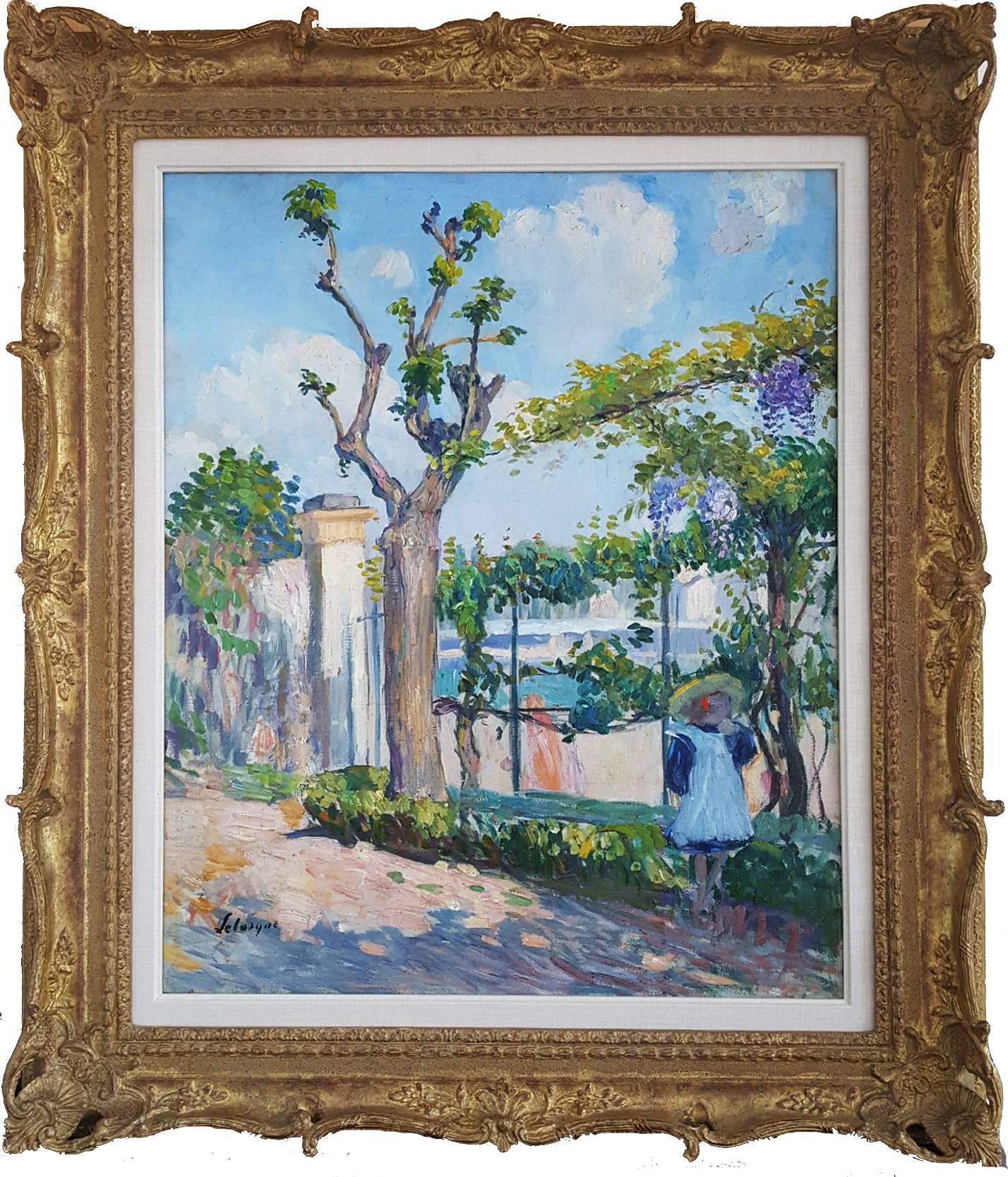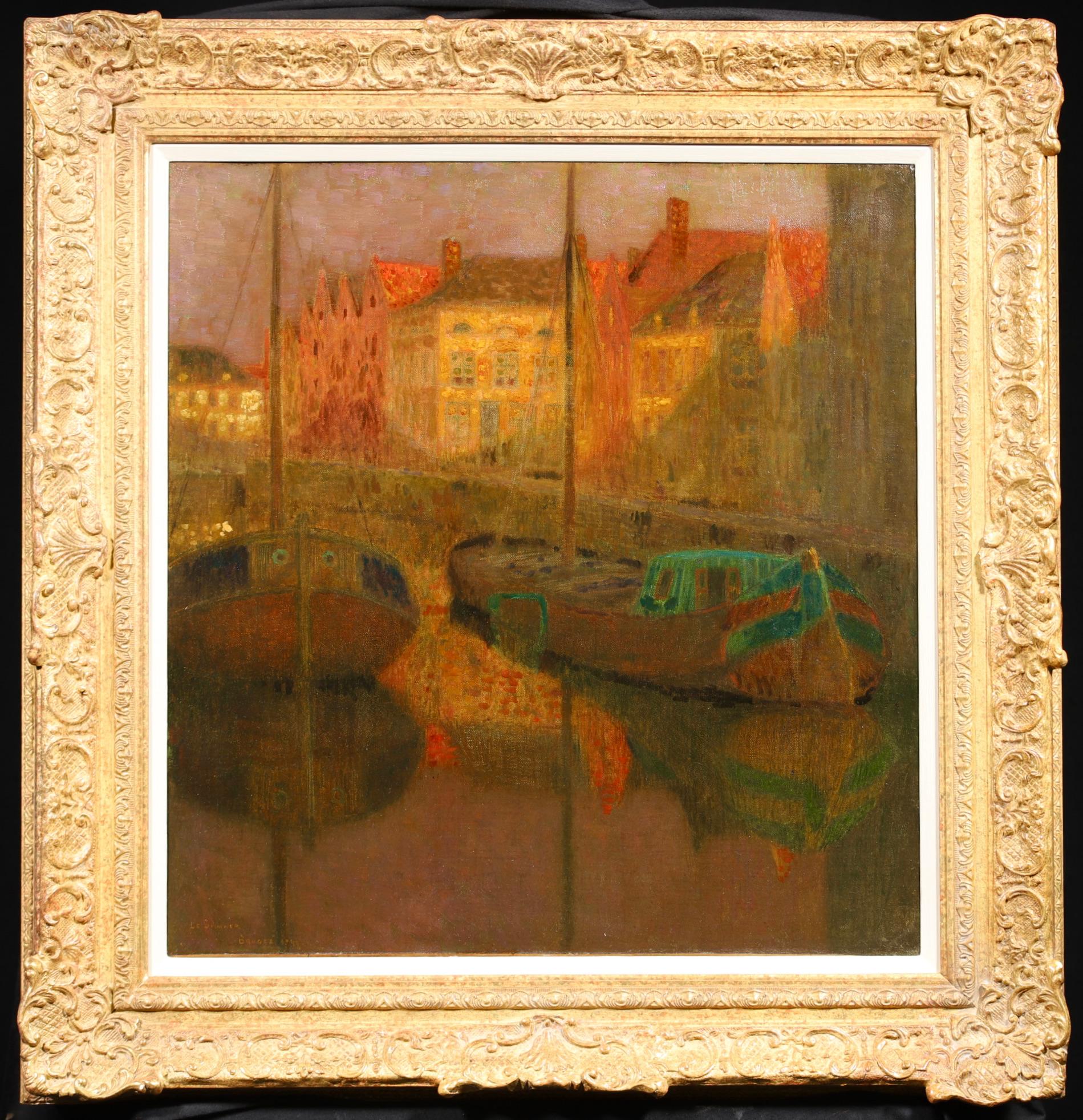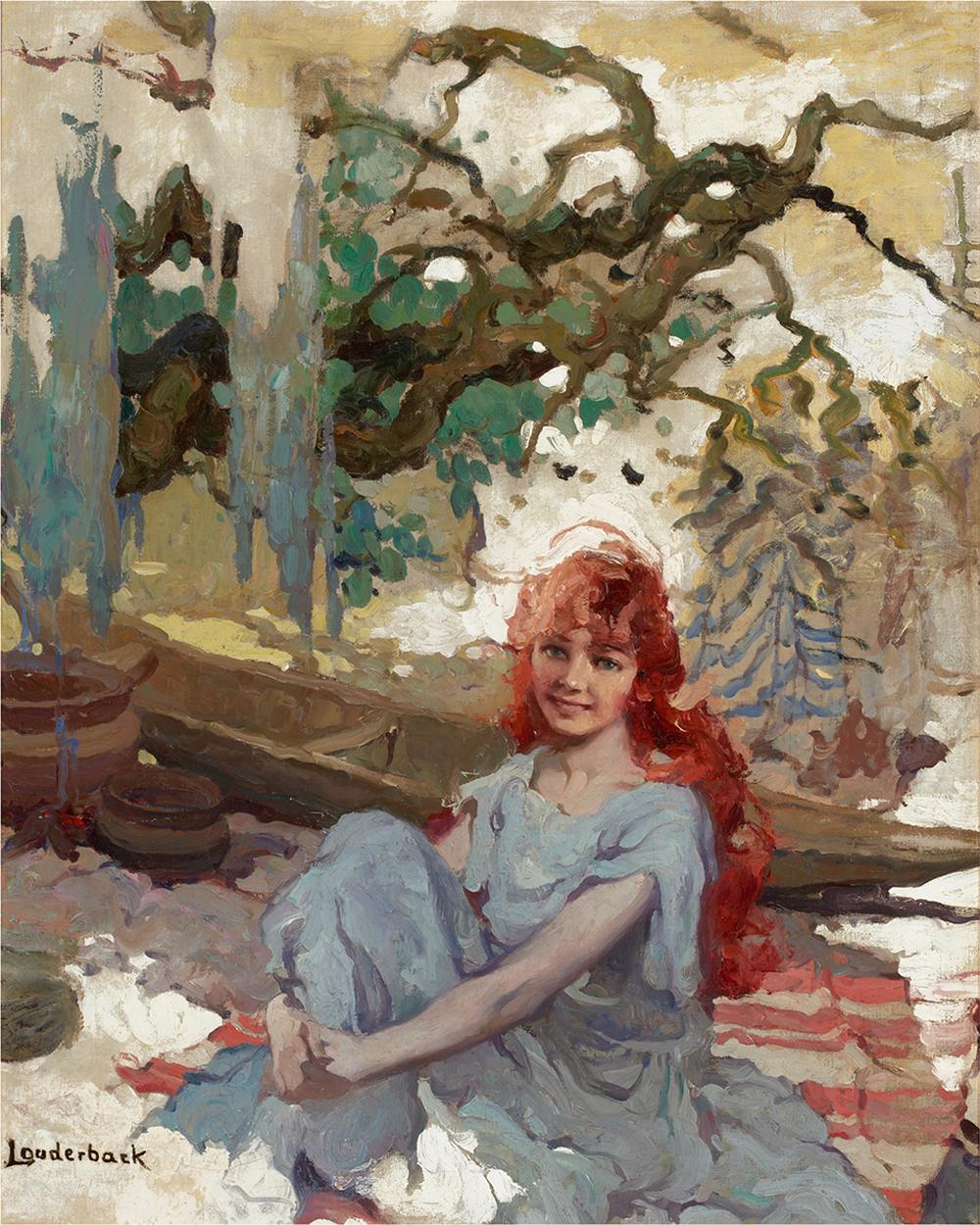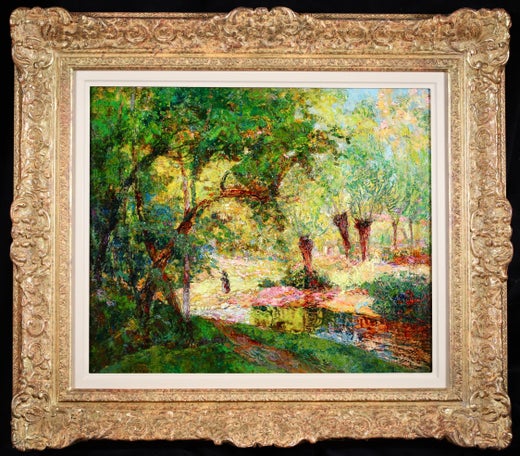Victor CharretonChurch Gardens - French Post Impressionist Oil, Landscape by Victor Charretonc.1910
c.1910
About the Item
- Creator:Victor Charreton (1864-1937, French)
- Creation Year:c.1910
- Dimensions:Height: 26 in (66.04 cm)Width: 31 in (78.74 cm)
- Medium:
- Movement & Style:
- Period:
- Condition:Very good condition.
- Gallery Location:Marlow, GB
- Reference Number:
Victor Charreton
Victor Charreton was the son of a surveyor. He spent his childhood in Chaumont and went to school in Bourgoin. In 1885 he began studying law at Grenoble University and in 1892 became a solicitor at the Lyons Court of Appeal. He had been creating paintings since childhood and was given advice by Ernest Hareux (he did not merely read his treatise on painting, which was highly regarded at the time) and also later by Louis Japy.
In 1902 Charreton gave up his legal career to devote his time to painting. The same year he moved to Paris. Every summer, from 1912 onwards, he would spend time at his house in St-Amant-Tallende near Clermont-Ferrand, where his wife came from. He also traveled abroad — to Algeria in 1905, to Spain and England in 1912 and to Belgium and Holland in 1913 — visiting numerous museums along the way. He also visited Corsica and Germany. He led the life of an aesthete and man of culture and was a lover of poetry and music. In 1914 he was made a Chevalier of the Légion d'Honneur.
Charreton was a landscape artist in the Lyons tradition with a love of sensual impasto. In his works he sought to capture fleeting, momentary effects, like those achieved by the Impressionists: effects at different times of day and in different seasons, such as dusk and snow. As a young man he painted the environs of Bourgoin, but his marriage in 1893 took him to Auvergne where he painted the characteristic landscapes of the region. Landscapes of Auvergne make up approximately two-thirds of Charreton’s output. What became known as the School of Murols, named after a village in Auvergne, was principally formed around him between 1910 and 1925. Skilled in capturing minute changes in the weather, he was also adept at capturing the spirit of new places.
Beside his native Dauphiné and his adopted Auvergne, Charreton was also charmed by the landscapes of the Île-de-France and Paris — Montmartre, the Jardin du Luxembourg and the Parc Montsouris — and also Provence, Creuse and Brittany. However, no trace has been found of his trips abroad. It would be a misjudgment to think that Charreton only painted pretty picture-postcard scenes in the regions he visited; on the contrary, he would seek out the intimist qualities of a place, choosing perhaps a quiet hamlet, with a humble bridge over an anonymous stretch of water, or an ordinary tree outside a tumbledown house.
Charreton would paint blazing autumn landscapes, with a sumptuous color palette, but also favored snowy scenes, their exact chromatic opposite. At the start of his career he would paint dusky scenes and contre-jours in halftones and misty sunsets. As Charreton’s artistic development progressed, he attached more and more importance to light and color. In this respect his work follows on from that of Ravier and, like Guillaumin, it is almost a precursor to Fauvism, or alternatively can be regarded as complicit with it, like the work of Maurice Marinot. Charreton’s brushwork evolved in tandem with his use of color, which became ever more vibrant; for example his fondness for purple hues and later his striking color contrasts. His brushwork became more conspicuous and he would suppress the insignificant details in order to bring out the forms that made up the general composition.
Among art historians Charreton is not ranked alongside the innovators who succeeded the Impressionists, like Gauguin, Seurat, Van Gogh or Cézanne. Older than Matisse, who was himself already by far the eldest of the Fauves, Charreton stopped short of what he considered to be their excesses. He placed himself at the crossroads between two centuries: the end of the century of Impressionism and the start of the leaps made by Fauvism. His life and the major themes in his work are evidence of this, but he decided to be a regional painter; as such, his talent and qualities are clearer than they may otherwise have been if he had chosen a more ambitious career. Beside his painting, he also wrote a play in three acts entitled The Montrouge Well (Le Puits de Montrouge), which was performed in Bourgoin in December 1883.
Charreton made his debut at the Lyons Salon in 1894 with Morning in Montpeyroux. That same year he began exhibiting in Paris at the Salon of the Société des Artistes Français, showing October Evening. He was awarded an honorable mention in 1910, a silver medal in 1912, a gold medal in 1913 and a commendation outside the competition in 1914. He also became a member of the committee and the jury and exhibited there until his death.
Charreton took part in collective exhibitions in France — in Toulouse, Clermont-Ferrand, Roubaix and Bordeaux — and abroad, in New York, Geneva and Barcelona. In 1915 he held a solo exhibition at the Galerie Georges Petit in Paris. He exhibited in New York, Toledo, Pittsburgh, Cleveland and Japan. In 1931 Charreton inaugurated the Musée de Bourgoin by donating around 20 works; the museum then changed its name to the Musée Victor Charreton. He was also one of the founders and general secretary of the Salon d'Automne. In 1972 the Musée de Montmartre organized a posthumous retrospective exhibition of his work; in 1987 and 1989 two more were held in a Paris gallery; then in 2003 the Musée de Bourgoin-Jallieu (in Isère) held in exhibition entitled “Victor Charreton: The Public Collections.”
Find original Victor Charreton art on 1stDibs.
(Biography provided by Leighton Fine Art)
- ShippingRetrieving quote...Ships From: Marlow, United Kingdom
- Return PolicyA return for this item may be initiated within 3 days of delivery.
- Barques de Peche - Post Impressionist Landscape Oil by Henri Le SidanerBy Henri Le SidanerLocated in Marlow, BuckinghamshireSigned post impressionist landscape oil on canvas by French painter Henri Le Sidaner. This stunning piece depicts two fishing boats moored in a fishing village at sunset. The last l...Category
1890s Post-Impressionist Landscape Paintings
MaterialsOil, Canvas
- Le Pont de Charenton - Post Impressionist Landscape Oil by Nathan GrunsweighLocated in Marlow, BuckinghamshireSigned post impressionist oil on canvas riverscape circa 1920 but Polish painter Nathan Grunsweigh. The work depicts a view of the bridge over the River Seine in Paris. A beautifully...Category
1920s Post-Impressionist Landscape Paintings
MaterialsCanvas, Oil
- Bathers on the Beach - Post Impressionist Landscape by Jacques-Emile BlancheBy Jacques Emile BlancheLocated in Marlow, BuckinghamshireSigned post impressionist oil on canvas landscape by French painter Jacques-Emile Blanche. The work depicts crowds of people enjoying a day at Brighton beach on the south coast of England. Bathers are dotted across the sandy beach with the pier on the right hand of the scene and the Grand Hotel behind. Signature: Signed lower right Dimensions: Framed: 29.5"x47.5" Unframed: 22.5"x39.5" Provenance: Private collection - Italy This work will be included in the catalogue raisonne of the work of Jacques Emile Blanche currently under preparation by Dr Jane Roberts & Muriel Molines Blanche received training from Gervex and Fernand Humbert. His grandfather was Émile Antoine Blanche, the psychiatrist who treated the poet Gérard de Nerval on several occasions. He was awarded a gold medal at the Exposition Universelle in Paris in 1900, and was a Commander of the Légion d'Honneur. He was well known in French and British artistic circles, and married the daughter of John Lemoine, the leader of the Diary of the Proceedings ( Journal des Débats), and author of the Life of Brummel. He exhibited his works in London and Paris. Blanche had a wide circle of acquaintances, and the list of portraits which he executed is indicative of the diversity of those who used to meet at his home: Henri Bergson; Stéphane Mallarmé; Henry Bernstein (1902); André Gide (1912); Anna de Noailles (1912); Jean Cocteau (1912); Igor Stravinsky (1915); Francis Jammes (1917); Paul Claudel (1919); Jean Giraudoux; Paul Valéry; Marcel Proust; Max Jacob (1921); Maeterlinck (1931); Debussy; Antoine Bourdelle; George Moore; André Maurois; François Mauriac; Maréchal Foch and the Princess de Broglie. He also wrote novels, which were more or less autobiographical, and essays, such as From David to Degas; Dates; From Gauguin to the Negro Review; Journals of an Artist ( De David à Degas; Dates; De Gauguin à la Revue nègre; Cahiers d'un artiste) in six volumes, and Manet. During meetings at his studio, he used to collect any snippets that would flesh out the essays he wrote, which alternated between being sharp and emotive. He gave them in series to the magazine Comoedia, under the title of Studio Talk. It was said that he aroused tremendous debate, notably with André Lhote, a painter younger than himself, who also doubled as a critic. The latter initially attempted to define the main characteristics of the art of the 'rebellious and charming Jacques Émile Blanche,' but subsequently treated him less generously, referring to a painter 'attached to the notion of 'high-and-mighty' genre painting.' He added that this sort of painting was marvellously illustrated by Manet. The quality of his flat surfaces, the precious greys and silvery light effects cause Jacques Émile Blanche to be compared more with Manet, whom he admired, than with the Impressionists, with whom he was compared in terms of his early works. Nevertheless, his outdoor backgrounds with traces of sometimes vivid colours have something in common with them. In the aftermath of World War I, he spent a long time on an enormous composition entitled Tribute to those who Died in the War. It was executed in a style which was totally different to his work as a whole. He offered this work to the church in Offranville near Dieppe. He also donated around 100 of his works to the Musée des Beaux-Arts in Rouen. He regularly exhibited in Paris, at the Salon of the Société Nationale des Beaux-Arts (also known as the Salon de Mars) from the time it was founded in 1890. At the time of the initial exhibitions held by the Société Nationale des Beaux-Arts, he rapidly gained fame by exhibiting such portraits as Paul Adam and Charles Cottet...Category
Mid-20th Century Post-Impressionist Landscape Paintings
MaterialsCanvas, Oil
- Les Grands Boulevards - Post Impressionist City Landscape Oil by Lucien AdrionBy Lucien AdrionLocated in Marlow, BuckinghamshireSigned figures in landscape oil on canvas circa 1920 by French post impressionist painter Lucien Adrion. The painting depicts people going about their daily lives on the streets of P...Category
1920s Post-Impressionist Landscape Paintings
MaterialsCanvas, Oil
- Paris - Post Impressionist Landscape Painting - Antoine BlanchardBy Antoine BlanchardLocated in Marlow, BuckinghamshireSigned post impressionist figures in cityscape oil on canvas circa 1960 by French painter Antoine Blanchard. The work depicts a bustling scene at Place de la Republique - a square in...Category
1960s Post-Impressionist Figurative Paintings
MaterialsCanvas, Oil
- Le champ de coquelicots - Post Impressionist Landscape Oil Painting - Marcel DyfBy Marcel DyfLocated in Marlow, BuckinghamshireSigned oil on canvas figures in landscape by sought after French post impressionist painter Marcel Dyf. The work depicts workers picking flowers in a poppy field in St Paul de Vence,...Category
1950s Post-Impressionist Landscape Paintings
MaterialsCanvas, Oil
- Bords du Loing by Alfred Sisley - Oil, landscape paintingBy Alfred SisleyLocated in London, GB*THIS PRICE INCLUDES 5% IMPORT DUTY APPLICABLE IF THE WORK REMAINS IN THE UK ONLY. Bords du Loing by Alfred Sisley (1839-1899) Oil on canvas 46.1 x 55.7 cm (18¹/₈ x 21⁷/₈ inches) S...Category
1890s Post-Impressionist Landscape Paintings
MaterialsCanvas, Oil
- Le Jardin de Lagny - Garden with young girl Post-impressionistBy Henri LebasqueLocated in Miami, FLLe Jardin de Lagny Provenance: Arthur Tooth, London Radon Gallery, NY This beautiful evocation of a lyrical French landscape is a fine example of of Po...Category
Early 1900s Post-Impressionist Landscape Paintings
MaterialsOil, Canvas
- "Theatre de Sara Barnhardt", Edouard Cortes, 13x18, Oil on Canvas, ImpressionismLocated in Dallas, TXTheatre de Sara Bernhart et Place de Chatelet by Edouard Cortes was painted circa 1935-40 and signed lower right. It is an oil on canvas measuring 13x18...Category
1930s Post-Impressionist Landscape Paintings
MaterialsOil, Canvas
- Girl with canoe painted in Arts and Crafts styleBy Walt LouderbackLocated in Miami, FLSigned lower left. Most likely for Saturday Evening Post or Colliers. Louderback is a painter/illustrator of the Golden Age of Illustration...Category
1920s Post-Impressionist Figurative Paintings
MaterialsCanvas, Oil
- "Boulevard of Paris", 20th Century oil on canvas by Spanish artist E. Grau SalaBy Emilio Grau SalaLocated in Madrid, ESEMILIO GRAU SALA Spanish, 1911 - 1975 BOULEVARD OF PARIS signed Grau Sala (lower right) oil on canvas 25-1/2 X 32 inches (65 X 81 cm.) framed: 36-1/4 X 42-1/2 inches (92 X 108 cm.) PROVENANCE Sale: Sotheby´s Olympia London, 20 October 2006 Emilio Grau Sala came from a family of artists. He was born in Barcelona in 1911 and his father, a good cartoonist, had been one of the promoters of the "Salon des Humanistes" and made his exhibitions normally in the Parés Hall. His first works were exhibited at the Salon des Independents, in the years 1930-33. Grau Sala was essentially a Mediterranean painter, son of post-impressionism and enriched with French painting of the last fifty years. In this work Grau Sala has a loose, subtle brushstroke, in which the color shapes the entire work. The bright and transparent whites that give life to young schoolgirls contrast with the brushstrokes of blacks from the nun who accompanies them. The explosion of greens is refreshing, it surrounds us and transports us to an idyllic place, even if it is a citizen boulevard, which becomes friendly and beautiful. His works can be found in the Museums of the Villa de Paris, L'Ile de France Museum, at the Château de Sceaux, Honfleur Museum, La Rochelle Museum, Barcelona Museum, Tossa de Mar...Category
1950s Post-Impressionist Landscape Paintings
MaterialsOil, Canvas
- Haystack with Resting FiguresBy John Maclauchlan MilneLocated in Hillsborough, NCScottish artist John Maclauchlan Milne, RSA, (1885-1957) is a contemporary of Scottish Colourists Peploe, Fergusson, Cadell and Hunter. Like the...Category
1920s Post-Impressionist Landscape Paintings
MaterialsCanvas, Oil






